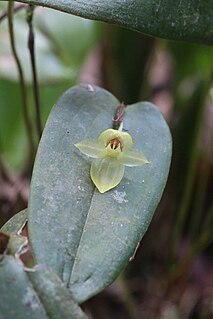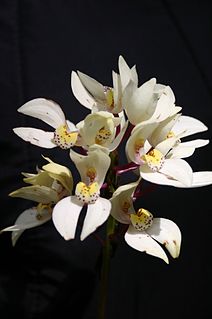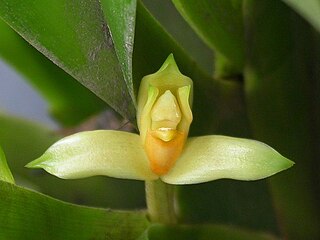
The Orchidaceae are a diverse and widespread family of flowering plants, with blooms that are often colourful and fragrant, commonly known as the orchid family.

Pleurothallis is a genus of orchids commonly called bonnet orchids. The genus name is derived from the Greek word pleurothallos, meaning "riblike branches". This refers to the rib-like stems of many species. The genus is often abbreviated as "Pths" in horticultural trade.

Cypripedioideae is a subfamily of orchids commonly known as lady's slipper orchids, lady slipper orchids or slipper orchids. Cypripedioideae includes the genera Cypripedium, Mexipedium, Paphiopedilum, Phragmipedium and Selenipedium. They are characterised by the slipper-shaped pouches of the flowers – the pouch traps insects so they are forced to climb up past the staminode, behind which they collect or deposit pollinia, thus fertilizing the flower. There are approximately 165 species in the subfamily.
The taxonomy of the Orchidaceae has evolved slowly during the last 250 years, starting with Carl Linnaeus who in 1753 recognized eight genera. De Jussieu recognized the Orchidaceae as a separate family in his Genera Plantarum in 1789. Olof Swartz recognized 25 genera in 1800. Louis Claude Richard provided us in 1817 with the descriptive terminology of the orchids.. The next step was taken in 1830-1840 by John Lindley, who recognized four subfamilies. He is generally recognized as the father of orchid taxonomy. The next important step was taken by George Bentham with a new classification, recognizing subtribes for the first time. This classification was first presented in a paper that Bentham read to the Royal Society in 1881. Then it was published in 1883 in the final volume of Genera Plantarum. The next great contributors were Pfitzer (1887), Schlechter (1926), Mansfeld (1937), Dressler and Dodson (1960), Garay, Vermeulen (1966), again Dressler (1981). and Burns-Balogh and Funk (1986). Dressler's 1993 book had considerable influence on later work.

Epidendrum, abbreviated Epi in the horticultural trade, is a large neotropical genus of the orchid family. With more than 1,500 species, some authors describe it as a mega-genus. The genus name refers to its epiphytic growth habit.

Govenia is a genus of plants belonging to the family Orchidaceae. The type species, Govenia superba, was transferred from Maxillaria superba and a genus name was given to commemorate J.R. Gowen, secretary of the Horticultural Society of London and confidential secretary to the Earls of Carnarvon.

Maxillaria, abbreviated as Max in the horticultural trade, is a large genus of orchids. This is a diverse genus, with very different morphological forms. Their characteristics can vary widely. They are commonly called spider orchids, flame orchids or tiger orchids. Their scientific name is derived from the Latin word maxilla, meaning jawbone, reflecting on the column and the base of the lip of some species, that may evoke a protruding jaw.
Calaway Homer Dodson was an American botanist, orchidologist, and taxonomist.

Bifrenaria, abbreviated Bif. in horticultural trade, is a genus of plants in family Orchidaceae. It contains 20 species found in Panama, Trinidad and South America. There are no known uses for them, but their abundant, and at first glance artificial, flowers, make them favorites of orchid growers.

Camaridium is a genus of epiphytic orchids widespread across the West Indies and through Latin America from Mexico to Bolivia. One species extends into Florida.

Mapinguari desvauxianus is a species of orchid native to tropical South America. It is known from French Guiana, Suriname, Guyana, Venezuela, Colombia, Ecuador, Peru, and Brazil.

Maxillaria notylioglossa, the Notylia-like Lip Maxillaria, is a species of orchid native to tropical South America.
Vargasiella is a genus of flowering plants from the orchid family, Orchidaceae. It contains two species, both endemic to South America: It has been treated as the only genus in the subtribe Vargasiellinae, but more recently has been included in the subtribe Zygopetalinae.
Ornithidium donaldeedodii is a species of orchids "discovered" in April 2010 when DNA analysis showed that a wrongly labeled orchid at the University of California Botanical Garden in Berkeley, California, was actually a distinct new species. The "new" orchid, which had been mislabeled as Maxillaria croceorubens since the 1990s, was named after orchidologist Donald D. Dod (1912–2008), who collected the specimen in the 1980s in Haiti. The new orchid was officially described in Lankesteriana, an international journal on orchidology, by authors James Ackerman of the University of Puerto Rico and W. Mark Whitten of the Florida Museum of Natural History.

Brasiliorchis is a genus of orchid. The genus includes species formerly placed in Maxillaria. It is found in South America.

Dendrobieae is a tribe in the subfamily Epidendroideae, in the family Orchidaceae.

Maxillariinae is an orchid subtribe in the tribe Cymbidieae. It was formerly treated as the tribe Maxillarieae, and divided into a number of subtribes.

Heterotaxis is a genus of orchids native to Latin America from central Mexico to Bolivia, and also to parts of the West Indies. One species extends into Florida.
- Heterotaxis brasiliensis(Brieger & Illg) F.Barros - Brazil
- Heterotaxis discolor(Lodd. ex Lindl.) Ojeda & Carnevali - Belize, Nicaragua, Venezuela, the Guianas, Bolivia, Brazil, Bolivia, Peru, Ecuador
- Heterotaxis equitans(Schltr.) Ojeda & Carnevali - Venezuela, Suriname, Guyana, Bolivia, Brazil, Bolivia, Peru, Ecuador
- Heterotaxis fritziiOjeda & Carnevali - Ecuador
- Heterotaxis maleolens(Schltr.) Ojeda & Carnevali - Chiapas, Central America
- Heterotaxis microiridifolia(D.E.Benn. & Christenson) Ojeda & Carnevali - Peru
- Heterotaxis santanae(Carnevali & I.Ramírez) Ojeda & Carnevali - Brazil, Ecuador, Venezuela
- Heterotaxis schultesiiOjeda & G.A.Romero - Brazil, Colombia
- Heterotaxis sessilis(Sw.) F.Barros - widespread from Veracruz and Florida south to Brazil
- Heterotaxis superflua(Rchb.f.) F.Barros - Brazil, Venezuela, the Guianas, Bolivia, Ecuador, Peru
- Heterotaxis valenzuelana(A.Rich.) Ojeda & Carnevali - Central America, Cuba, Venezuela, Colombia, Ecuador, Brazil
- Heterotaxis villosa(Barb.Rodr.) F.Barros - Brazil, Venezuela, the Guianas, Bolivia, Ecuador, Peru, Colombia
- Heterotaxis violaceopunctata (Rchb.f.) F.Barros - Brazil, Venezuela, the Guianas, Ecuador, Peru, Colombia

Camaridium vestitum, called purple tiger orchid, is a species of epiphytic orchids native to Florida, the West Indies and through Latin America from Mexico to Bolivia.















